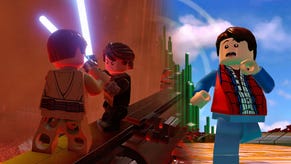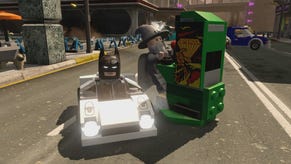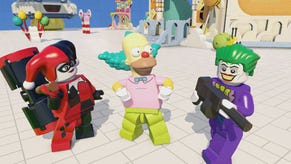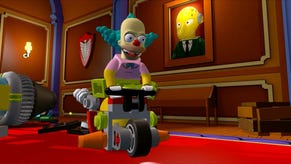LEGO Dimensions Wii U Review: Everything is Awesome (Except the Actual Game)
A towering achievement in fanservice, wrapped around something that barely qualifies as a video game.
This article first appeared on USgamer, a partner publication of VG247. Some content, such as this article, has been migrated to VG247 for posterity after USgamer's closure - but it has not been edited or further vetted by the VG247 team.
Looks can be deceiving, as the saying goes, but that isn't always the case. Certainly looks are perfectly representative of LEGO Dimensions—and more's the pity.
Until Dimensions, I'd never actually played a LEGO titles myself. I've looked over plenty of shoulders as friends, coworkers, and relatives have played games like LEGO Star Wars, though. I've always found myself struck by the charm of the little toy-based renditions of great media properties while simultaneously being puzzled about the games themselves. Namely, there never actually seemed to be much game there. Was there some hidden depth to the LEGO franchise that I simply hadn't cottoned to? Would playing rather than merely observing reveal the secret value lurking beneath the surface?
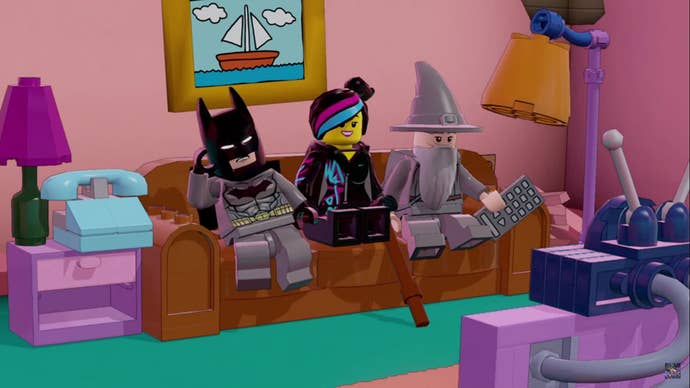
As it turns out, no.
LEGO Dimensions offers players a hacky, brain-dead, lowest-common-denominator approach to action games. It's a hot mess of conflicting contextual commands and poorly communicated level design trapped in a mindless collect-a-thon Skinner box. At best, it's an exercise in tedium and button-mashing; at worst, it's actively disrespectful to players, their time, and most of all, their money.
What makes this miserable excuse for game design doubly frustrating is the fact that it comes dressed in an absolutely delightful mishmash of pop culture references and properties. This is a game where Marty McFly, the First Doctor, Batman, and Chell from Portal 2 can team up to save Springfield from Mr. Burns immediately after following the Yellow Brick Road through Oz. Every beloved character comes surrounded by witty little in-jokes that dig deep into their franchise's lore and fan memes, and the interactions between these different heroes and heroines—while limited—are packed with punchy quips.
Unfortunately, Dimensions sorely lacks the substance to justify this pop pile-up. Once you scrape past the appealing surface, underneath the façade you'll find nothing. It doesn't really matter which media franchise appeals to you most, because whether you're a fan of Doctor Who or Scooby-Doo, the goals and methods of each "world" turn out to be precisely the same. You wander around collecting LEGO bricks, looking for LEGO structures that can be destroyed. One or two of these objects will leave behind bricks that rather than simply fade away instead linger and pulsate, which is your cue to turn them into an object you need to advance to the next portion of the level.
But there's no real substance to this, no cleverness of design. Certainly LEGO Dimensions offers no sense of player agency. It's never really clear what you're supposed to do at any given time to advance, and once you do find the LEGO bricks you're meant to reassemble, you have no control over the outcome. Solving a puzzle amounts to holding a button while your minifig avatar automatically configures bricks into whatever arbitrary form is required to proceed. It really feels like the worst of modern gaming's reliance on contextual commands boiled down beyond the point at which anything is actually left beyond a meandering exercise in automatic tasks of no particular import.

I'm perfectly willing to concede that LEGO Dimensions isn't for me, though. Clearly this is a game for kids, so I didn't just play alone—I played Dimensions with, and observed the play patterns of, two novice gamers: A young kindergarten-age cousin, and my mother (whose last serious video experience involved Atari's Centipede back when it was brand new). Disappointingly, Dimensions turned out to be every bit the same aimless, unintuitive, trial-and-error slog for them as it was for me. Actually, I'd have to say it was worse for them; at least I'm well-versed in the vocabulary of video games and knew the clichés and rules that Dimensions incorporates so amateurishly. My fresh-faced family members, on the other hand, had a much worse time of it, unable to call on decades of rote mechanics to guide them whenever the game itself failed to do so (which, unfortunately, was "always").
Despite its brain-dead simplicity of design, Dimensions also commits the tragic sin of surrounding its inanity with a shell of maddening complexity. I don't know if it's meant to be smoke-and-mirrors to hide the ultimate emptiness of the game design or just that developer TT Games keeps bolting on more and more superfluous features to a fundamentally simplistic game concept with each new sequel, but Dimensions has a taxing interface. It doesn't help that the add-on set my mother was interested in trying—Doctor Who, of which she's a huge fan—has the most complicated object in the game in the form of its TARDIS time machine, which works as a vehicle, exists as a separate play space, can fly in fully three dimensions, offers a stealth mode, and serves as the key to multiple time-travel puzzles. That's a lot for an inexperienced player to keep up with, especially when their last video game session involved nothing more than a trackball and a fire button.
And the toys-to-life aspect of Dimensions just increases the hassle. The game will occasionally incorporate the toy portal into the design, whether by forcing you to change the actual physical position of your active figure or by integrating its colored LED light functions into puzzles. It never feels intuitive, though, and usually does more harm than good. Occasionally the game will come to a standstill while you're forced to assemble LEGO toys—the add-on play sets only include paper instructions for the minifig—which destroys the already terrible pacing. And while you can have more than half a dozen figures and vehicles on the NFC portal, TT didn't really bother to change Dimensions' design to accommodate all of these elements. Step out of the TARDIS, for example, and your active character will quickly become stuck in the door as all the other figures and vehicles materialize around them. It's unbelievably sloppy, and it sadly goes hand in hand with the enormous number of bugs I've seen in the game—for example, a character infinitely spawning in a location that instantly kills them as soon as they revive, forever. Like a tiny LEGO interpretation of Hell.
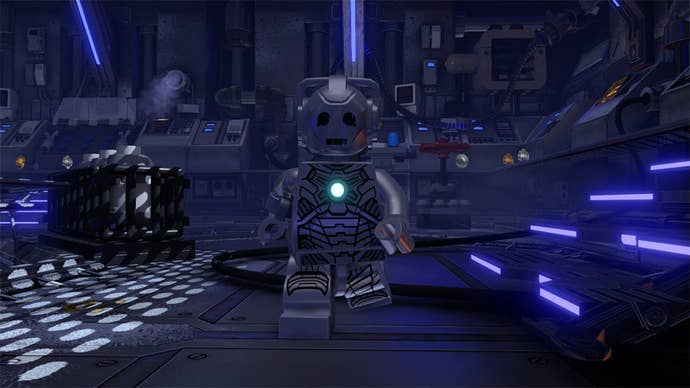
Not that it matters if you die; LEGO Dimensions lacks anything akin to challenge. When a character runs out of health, they explode into a shower of bricks, then immediately rematerialize. There's no significant penalty for this, no incentive to play well... which is definitely for the best, given the mediocrity of the combat design. LEGO comes in dead last in terms of playability among this year's toys-to-life crop. Compared to the solid platformer mechanics of Skylander and the impressively varied melee combo and evasion techniques of Disney Infinity, Dimensions feels like a joke.
In short, there is not a single area in which LEGO Dimensions excels as a video game; in many places, it falls well short of competent. Yet despite all of these frustrations, it's bizarrely addictive to play. My mother, an incredibly patient woman (as she'd have to be, as the parent of someone who ended up writing about video games for a living), exhibited rare signs of frustration and impatience as she played. This was partially brought on by the inexplicable shortage of save points in the Doctor Who module—it would take an experienced player a good hour of play time before reaching a point at which you can record your progress, and much more than that for someone learning the ropes and rules of play. She ended up going through the London stage three times before finally being able to record what she'd accomplished. Compounded with Dimensions' other design failings, it made for an absolutely miserable reintroduction to the medium after 30-plus years.
And yet, she's expressed her determination to see the game through to the end next time she comes to visit. LEGO Dimensions may not offer much in terms of being a video game, but as a work of fan service, it's quite remarkable. Take the Doctor Who sections she spent so much time with; it actually makes active use of the constant, no-penalty deaths that define the LEGO games by respawning the Doctor as a different incarnation each time. While there are some weird inconsistencies to the different doctors—most of the older incarnations have no dialogue, though the First Doctor will occasionally spout samples from the old TV show—each of them looks the part. Not only that, but the TARDIS interior changes to reflect your current Doctor, including an absolutely wonderful black-and-white grain filter on the First Doctor's TARDIS to reflect the look of those 50-year-old shows. You can ride around on K-9 and take missions from familiar NPCs like the ever-libidinous Jack Harkness, and of course the Daleks and Cybermen you fight are spot on: Being blasted by a Dalek even causes a character to briefly be rendered as a LEGO skeleton. And that's not even mentioning all the little touches, like the fact that the Doctor's health icons are represented not as a heart, but as two overlapping hearts. Because, you know, Time Lords.
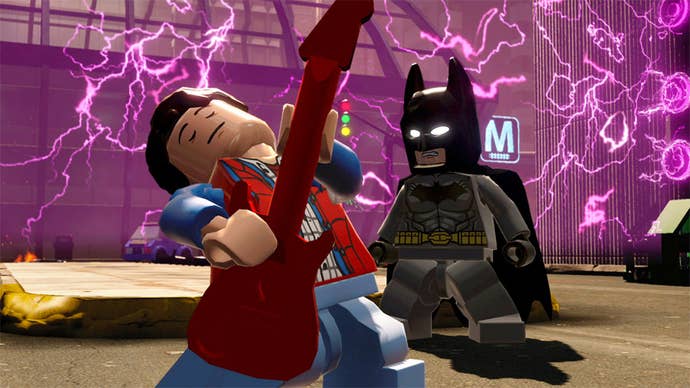
That same level of love has been invested into every property on display here, from The Wizard of Oz to Midway's own classic arcade games. Dimensions' core adventure basically sends you on a romp through a dozen or so familiar universes, each one packed with in-jokes and references, and the central hub world includes portals to expanded material within those worlds... provided you've bought the correct figures, of course.
And that's the rub. Dimensions offers glorious, fan-pleasing renditions of an incredibly broad array of fictional universes, but the buy-in is unbelievably expensive. The base price for the starter set is $99, and each expansion runs another $30. Yeah, you get a few LEGO toys for your money, but I have trouble seeing where a tiny set consisting of a figure, two tiny vehicles, and a poorly designed story mission that can be completed in a couple of hours justifies that cost. I make a policy of not reviewing based on a game's price, but this is definitely a case where you'll want to look before you leap. Even if you score some crazy Black Friday deal next week, Dimensions is going to be incredibly expensive.
Naturally, it's pure crack cocaine to its target audience of kids. They aren't old enough to know good game design from bad, and why should they care? Dimensions is an opportunity for them to play as Batman and Gandalf and Scooby Doo and Bart Simpson, both in the game and out. They're not going to complain if the mechanical design that surrounds those characters is insipid and lifeless. And that's the real tragedy of LEGO Dimensions—the design of TT's LEGO games desperately needs to evolve, but it won't, because the strength of the licenses and the appeal of the LEGO toys included trumps the fact that it is by far the worst of this year's toy/game combo products.
InterfaceUnspeakably clumsy, with overlapping contextual commands, awkward minigames, and unintuitive goals.
Lasting AppealThere's a lot of stuff to collect, if you can bear the mundanity of it all. Otherwise, the charm of Gandalf spouting the same few joke clips wears off fast.
SoundEvery sound is culled from beloved movies, games, and TV shows, so the heavy lifting was already taken care of.
VisualsPretty nice! Although the game discards the LEGO visual metaphor seemingly at random for background elements.
ConclusionLEGO Dimensions feels like the bare minimum required to qualify as a video game in this day and age—it's a shallow, repetitive experience that leans heavily on the appeal of LEGO toys and a dozen very expensive licenses... which probably explains why the $99 starter set only gives you access to a fraction of the total game content. There's nothing necessarily wrong with the toy expansion concept, but Dimensions' only advantage over its better-designed (and less expensive) competitors is the appeal of its license. Between its high cost, lowbrow design, and kid-addicting façade, Dimensions feels downright predatory. But the fanservice is great!

